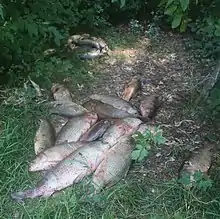Bigmouth buffalo
The bigmouth buffalo (Ictiobus cyprinellus) is a fish native to North America, and it is in decline.[2][3][4] It is the largest North American species in the Catostomidae or "sucker" family, and is one of the longest-lived and latest-maturing freshwater fishes, capable of living beyond 110 years and reproducing infrequently.[5] It is commonly called the gourdhead, marblehead, redmouth buffalo, buffalofish, bernard buffalo, roundhead, or brown buffalo. The bigmouth buffalo is not a carp, nor is any other fish in the sucker family. Although they share the same order, each belong to different suborders and are native to separate continents.
| Bigmouth buffalo | |
|---|---|
 | |
| Bigmouth buffalo male | |
| Scientific classification | |
| Kingdom: | Animalia |
| Phylum: | Chordata |
| Class: | Actinopterygii |
| Order: | Cypriniformes |
| Family: | Catostomidae |
| Genus: | Ictiobus |
| Species: | I. cyprinellus |
| Binomial name | |
| Ictiobus cyprinellus (Valenciennes, 1844) | |
| Synonyms | |
| |
The bigmouth buffalo is typically a brownish olive color with dusky fins, but can vary greatly in color across individuals. Like other catostomids it has a long dorsal fin, but unlike all others it has a terminal (forward-facing) mouth reflecting its unique, pelagic feeding ecology. It is the largest of the buffalo fish and can reach a length of more than 4 ft (1.2 m) and 65 lb (29 kg) in weight. Generally, it lives in sluggish areas of large rivers and in lakes. Bigmouth buffalo populations have been in decline in the northern extent of their range since the 1970s, including parts of Minnesota, North Dakota, and Canada.[2] A 2019 study documented their late maturity, centenarian longevity, and that several populations in northwestern Minnesota are comprised mainly (85-90%) of individuals more than 80 years old, indicating recruitment failure since the 1930s.[5] These life history attributes, including the ability to survive decades with virtually no successful recruitment (i.e. periodic recruitment), are shared by other long-lived freshwater fishes, including sturgeon.[5] Such species require time to successfully sustain themselves, surviving to periods in which favorable environmental conditions arise that allow for booms in reproduction and subsequent recruitment.[6] Management of bigmouth buffalo is thus in urgent need of reevaluation, at least in the northern part of their US range where populations are already declining;[2] there are no limits on harvest, and night bowfishing was recently legalized, allowing a new and growing form of exploitation.[5][7]
Geographic distribution
The bigmouth's native distribution is confined to the countries of Canada and the United States of America.[8] It is native to the Red River of the North and Mississippi River drainage basins, from Manitoba, Canada, and North Dakota, United States, to the Ohio River and south in the Mississippi River system to Texas and Alabama. In Canada, they inhabit the Milk River which flows through Alberta, and the Qu'Appelle River which flows through Saskatchewan and Manitoba into Lake Winnipeg. Beginning in the northern United States, they are native to Montana, North Dakota, Minnesota, Wisconsin, and down to southern states including eastern Texas, Oklahoma and Louisiana. The major systems where they are found include the Hudson Bay and Mississippi River drainages. The introduction of bigmouth has largely been done for commercial purposes. Regions of reintroductions include some reservoirs along the Missouri River drainage of North Dakota and Montana. Regions of introduction include some reservoirs in Arizona, and within California, they have also been introduced to the aqueduct system of Los Angeles.[9]

Ecological, cultural, and economic importance
Native to North America, bigmouth buffalo are integral to ecosystems therein. Bigmouth buffalo young are prey for several predatory fish, including walleye,[13] northern pike,[14] catfish,[15][16] alligator gar,[17][18] etc. Bigmouth buffalo filter-feed on invasive zebra mussels during the mollusk's larval (veliger) planktonic stage.[19][20] They form the native counterpart to the invasive bighead and silver carp, and they compete with the invasive common carp. However, these invasive species are outcompeting native bigmouth buffalo.[5][20][16] Native Americans utilized bigmouth buffalo, Lewis and Clark harvested them on their journey in 1804, and the inland commercial fishing industry has valued them as a prized catch since the 1800s.[5] The bigmouth buffalo is a popular foodfish throughout the United States, and has been introduced into a few southwestern states. Commercial harvesters have to obtain annual permits to net from designated waterbodies, which are rotated among on a year-by-year basis, and they must report harvest from each haul to their respective state agency. Bigmouth buffalo are then trucked in oxygenated water tanks to markets where they are sold alive.[21] Though it has small bones suspended in its muscle tissue like northern pike, its good flavor makes it one of the most valuable of the traditional, non-game freshwater fish. In addition to being a foodfish, the bigmouth buffalo has recently become a sportfish, as night and day bowfishing have become increasingly popular since 2010.[5]
Ecology
The bigmouth buffalo has a rather unique, pelagic ecology of shallow-water systems. The larval bigmouths are pelagic and sometimes benthic feeders of copepods and cladocerans mostly, but also eat phytoplankton and chironomids.[8][22] Bigmouth buffalo, unlike its close relatives the black and smallmouth buffalos, is a pelagic filter-feeder, using its very fine gill rakers to strain zooplankton from the water. It sometimes feeds near the bottom, using short up-and down movements to filter from the water the animals that hover near the bottom or rest lightly on it.[23] The juveniles and adults are mostly limnetic plankton feeders that also eat cladocera, copepods, algae, Chironomidae, ostracods, and other insect larvae and invertebrates depending on availability.[24][25] The optimum habitat for spawning bigmouth buffalo is highly vegetated waters. They are a very resilient fish that can tolerate high turbidity and low oxygen levels. They can be found in waters with turbidity levels over 100 ppm. A minimum total dissolved solids is 200 ppm during the growing season. During spring and summer, 50–75% pools should be present, with backwaters, and marsh areas and 25-75% littoral area and protected embayments during summer for the habitat to be suitable.[9] Bigmouth can be found in waters from 22.5–38.0 °C, but their preferred temperature is between 31 and 34 °C. The optimal temperatures for incubation and hatching of eggs are from 15-18 °C, but they can develop in temperatures reaching up to 26.7 °C.[9] The bigmouth prefers slow-moving water that does not reach a velocity over 30 cm/s. Salinity can be a problem for reproduction. Spawning can occur from 1.4-2.0 ppt of salinity which eggs and yearlings not being able to survive a salinity of over 9 ppt.[26] The minimum dissolved oxygen during the spring and summer is 5 mg/l.[9]

The bigmouth buffalo migrates upstream to spawning in the spring, usually April to June, where it lays its eggs on plants to which they adhere. More than one male will assist in spawning by moving the female to the top of the water to help mix eggs and milt. This species of buffalo will also occasionally spawn in rock and gravel (open substrata) in the spring.[28] Bigmouth buffalo are susceptible to anchor parasites which can lead to secondary infections which can be harmful in poor water conditions.[29]

Life history
At 112 years of age, the bigmouth buffalo is the oldest known freshwater teleost (a group of about 12,000 species) by nearly 40 years, shattering all previous records for this group.[5][11] With a previous maximum longevity estimate for this species at 26 years,[30] supercentenarian longevity came as a surprise and was initially met with skepticism.[31]
Thorough bomb radiocarbon dating was conducted on their otolith microstructure and confirmed the old age estimates generated from thin-sectioned otoliths, making bigmouth buffalo the oldest age-validated freshwater fish in the world.[5][12] The bigmouth buffalo is a spring spawner generally spawning between April and June when the water temperature is between 13 and 26 °C. The bigmouth is a broadcaster that has adhesive eggs, which it lays in highly vegetated waters. Females seek highly submergent and emergent vegetation, which is ideal habitat for the hatching of their eggs. The substrate found is generally a mixture of a medium amount of rubble and gravel and a high amount of sand and silt.[32] The water levels substantially rise before spawning and stabilize afterwards. The sexual maturity of bigmouths is mostly unknown and likely varies with latitude. In southern Minnesota, females begin to mature once they are around 10 years old, while males around 6 years old.[5] This is substantially older than previously assumed using inadequate aging techniques, indicating a much slower life pace than previously realized. Bigmouth buffalo have a tendency to accumulate unique pigmentation (orange and black spots) as they age.[5][12] The bigmouths are group spawners which produce 250,000 eggs/kg of adult weight; their eggs are about 1.5 mm in diameter.[29]
Conservation status

Bigmouth buffalo's conservation status is in urgent need of reassessment.[5] The bigmouth buffalo is an endangered fish species in Pennsylvania.[33] Besides this state, the bigmouth buffalo is not currently listed as threatened or endangered in any other region of its native distribution, even though they have had Special Concern status in Canada since the 1980s,[5][3] and have been known as declining in the northern extent of their US range since the 1970s.[2] Surprisingly, several longstanding US populations are composed almost totally (85-90%) of individuals hatched before 1940, while harvest limits do not exist in these same areas - this despite the rapidly growing new sport of modernized night bowfishing that exploits this species. The fingerlings are susceptible to a parasite, Lernea cyprinacae, but most are unaffected by the time they reach a length of 30 mm.[29] They are anchor parasites that insert themselves between scale margins and fin insertions. The real problem is a secondary infection that may arise due to these parasites, the protozoan Epistylis and bacteria Flavobacterium columnare are both attached to serious parasite infestations.[29] The bigmouth has been seen to hybridize in the wild with smallmouth buffalo, and it is possible that some fish identified as black buffalo are indeed these hybrids.[34] The hybridization does not seem to be negatively affecting their populations but makes it difficult to determine how many hybrids and how many black buffalo are actually in certain reservoirs. The fish is vulnerable in shallow water and is often captured by bow and arrow. It is commercially caught on trotlines, setlines, hoop and trammel nets, and seines. There are currently no found specific management plans for the bigmouth buffalo either privately or governmentally funded in the US. In some places like the southern US, progeny have been reared in hatcheries.[29]
Records
On June 21, 2013, Noah LaBarge (13 years old) caught the Wisconsin state record bigmouth buffalo fish.[35] It measured 49.5 inches (126 cm) and weighed 76.8 pounds (34.8 kg). It was caught on an 8-lb-test line on the Wisconsin River at Devil's Elbow, which is on the north end of the Petenwell Flowage. It was officially recognized to be the new world record by the National Fresh Water Fishing Hall of Fame as both 8-lb-line class and all tackle. A Mt. Juliet, Tennessee, a man caught a record 62-pound (28 kg) bigmouth buffalo while fishing on Percy Priest Lake. The fish, caught by Jeff Wilkins in late March, was 45 inches (110 cm) in length and snagged in the Seven Points area of the lake. The Tennessee Wildlife Resources Agency said it took him 35 minutes to reel in the fish. The new record surpasses the previous mark of 52 pounds, 2 oz, previously held since April 6, 2001, by Greg Megibben. The giant fish also came from Percy Priest Lake. After the record was certified, Wilkins released the fish back into the lake. In Omaha, Nebraska, Joe Slavic caught a 64-pound (29 kg) bigmouth buffalo on June 8, 2000, in a sand pit located in Dodge County.
See also
References
- NatureServe (2013). "Ictiobus cyprinellus". The IUCN Red List of Threatened Species. IUCN. 2013: e.T202127A18234087. doi:10.2305/IUCN.UK.2013-1.RLTS.T202127A18234087.en.
- EDDY, SAMUEL; UNDERHILL, JAMES C. (1974). Northern Fishes: With special reference to the upper Mississippi valley (NED - New ed.). University of Minnesota Press. ISBN 9780816606740. JSTOR 10.5749/j.ctttt6n9.
- "COSEWIC Assessment and Update Status Report on the Bigmouth Buffalo Ictiobus cyprinellus" (PDF). 2009.
- Starr, Michelle. "The Oldest Freshwater Fish Ever Found Just Changed What We Know About Fish". ScienceAlert. Retrieved 2020-05-31.
- Lackmann, Alec R.; Andrews, Allen H.; Butler, Malcolm G.; Bielak-Lackmann, Ewelina S.; Clark, Mark E. (2019-05-23). "Bigmouth Buffalo Ictiobus cyprinellus sets freshwater teleost record as improved age analysis reveals centenarian longevity". Communications Biology. 2 (1): 197. doi:10.1038/s42003-019-0452-0. ISSN 2399-3642. PMC 6533251. PMID 31149641.
- Winemiller, Kirk O.; Rose, Kenneth A. (1992-10-01). "Patterns of Life-History Diversification in North American Fishes: implications for Population Regulation". Canadian Journal of Fisheries and Aquatic Sciences. 49 (10): 2196–2218. doi:10.1139/f92-242. ISSN 0706-652X.
- Scarnecchia, Dennis L.; Schooley, Jason D. (October 2020). "Bowfishing in the United States: History, Status, Ecological Impact, and a Need for Management". Transactions of the Kansas Academy of Science. 123 (3–4): 285–338. doi:10.1660/062.123.0301. ISSN 0022-8443.
- Johnson, R. P. (1963-06-01). "Studies on the Life History and Ecology of the Bigmouth Buffalo, Ictiobus cyprinellus (Valenciennes)". Journal of the Fisheries Research Board of Canada. 20 (6): 1397–1429. doi:10.1139/f63-095. ISSN 0015-296X.
- Edwards, E.A. 1983. Habitat Suitability Index Models: Bigmouth Buffalo. U.S. Dept. of the Interior, Fish and Wildlife Service. FWS/OBS-82/10.34. 23 pp.
- Apr 22nd 2016 - 11pm, Tom Cherveny |. "Where buffalo fish swim, nets follow". West Central Tribune. Retrieved 2020-05-26.
- "112-year-old fish has broken a longevity record". National Geographic. 2019-08-02. Retrieved 2020-05-28.
- May 29th 2019 - 1pm, Mike McFeely |. "McFeely: NDSU researcher finds some Minnesota fish live more than 100 years". INFORUM. Retrieved 2020-05-29.
- Liao, H.; Pierce, C. L.; Larscheid, J. G. (2002). "Diet dynamics of the adult piscivorous fish community in Spirit Lake, Iowa, USA 1995–1997". Ecology of Freshwater Fish. 11 (3): 178–189. doi:10.1034/j.1600-0633.2002.00015.x. ISSN 1600-0633.
- Mauck, Wilbur L.; Coble, Daniel W. (1971-07-01). "Vulnerability of Some Fishes to Northern Pike (Esox lucius) Predation". Journal of the Fisheries Research Board of Canada. 28 (7): 957–969. doi:10.1139/f71-141. ISSN 0015-296X.
- Neely, Ben C.; Lynott, Sean T. (September 2016). "Examination of the World Record Flathead Catfish Captured from Elk City Reservoir, Kansas, in May, 1998". Transactions of the Kansas Academy of Science. 119 (3–4): 353–359. doi:10.1660/062.119.0419. ISSN 0022-8443. S2CID 88656666.
- "Trash Fish Tuesday: Bigmouth Buffalo". www.themeateater.com. Retrieved 2020-05-29.
- "In Texas, One of the World's Oldest, Weirdest Fish Finally Gets its Due". The Texas Observer. 2018-11-19. Retrieved 2020-05-26.
- Layher, William (September 24, 2008). "Literature Survey, Status in States of Historic Occurrence, and Field Investigations into the Life History of Alligator Gar in the Ouachita River, Arkansas" (PDF). Inc., Pine Bluff, Arkansas.
- "New appreciation for a Minnesota fish long considered junk". MPR News. Retrieved 2020-05-25.
- "112-Year-Old Bigmouth Buffalo Is World's Oldest Freshwater Bony Fish". IFLScience. Retrieved 2020-05-29.
- Apr 22nd 2016 - 11pm, Tom Cherveny |. "Where buffalo fish swim, nets follow". West Central Tribune. Retrieved 2020-05-26.
- McComish, T.S. 1967. Food Habits of Bigmouth and Smallmouth Buffalo in Lewis and Clark Lake and the Missouri River. Transactions of the American Fisheries Society 96: 70-74.
- (Pflieger 1997)
- Applegate, R.L. and Starostka, V.J. 1970. Food Selectivity of Bigmouth Buffalo, Ictiobus cyprinellus, in Lake Poinsett, South Dakota. Transactions of the American Fisheries Society 99: 571-576.
- Johnson, J.E., Minkley, M.L., Rinne, J.N., and Willoughby, S.E. 1970. Foods of Buffalofishes, Genus Ictiobus, in Central Arizona Reservoirs. Transactions of the American Fisheries Society 99: 333-342.
- Hollander, E.E. and Avault, J.W. 1975. Effects of Salinity on Survival of Buffalo Fish Eggs Through Yearlings. The Progressive Fish-Culturist 37: 47-51
- "Research proves Midwestern fish species lives beyond 100 years". phys.org. Retrieved 2020-05-28.
- Simon, T. P. 1999. Assessment of Balon’s reproductive guilds with application to Midwestern North American Freshwater Fishes, pp. 97-121. In: Simon, T.L. (ed.). Assessing the sustainability and biological integrity of water resources using fish communities. CRC Press. Boca Raton, Florida. 671 pp.
- Kleinholz, C.W. 2000. Species Profile: Bigmouth Buffalo. Southern Regional Aquaculture Center Publication Number 723.
- Paukert, Craig P.; Long, James M. New Maximum Age of Bigmouth Buffalo, Ictiobus cyprinellus. CiteSeerX 10.1.1.967.8032.
- "Doctoral student challenges book on Bigmouth Buffalo" (PDF). Minnesota Outdoor News.
- Lane, J.A., Portt, C.B. and Minns, C.K. 1996. Spawning habitat characteristics of Great Lake fishes. Canadian Manuscript Report of Fisheries and Aquatic Science 2368: v-48.
- "Endangered fish caught and released in Lake Erie". Pittsburgh Post-Gazette. Retrieved 2020-03-10.
- Johnson, D.W. and Minckley, W.L. 1969. Natural Hybridization in Buffalofishes, Genus Ictiobus. American Society of Ichthyologists and Herpetologists 1969: 198-200.
- http://dnr.wi.gov/topic/fishing/documents/recordfish/WisRecordFishAug2013.pdf
External links
 Data related to Ictiobus cyprinellus at Wikispecies
Data related to Ictiobus cyprinellus at Wikispecies Media related to Ictiobus cyprinellus at Wikimedia Commons
Media related to Ictiobus cyprinellus at Wikimedia Commons
